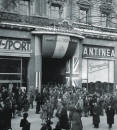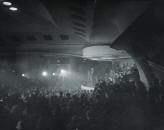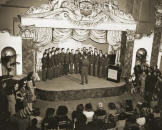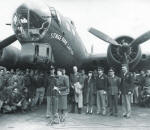Where could a GI enjoy the best big bands, dance with the ladies, and rub elbows with the likes of Marlene Dietrich? Only at the Stage Door Canteen.
By Cathy K. Urwin
It was an odd message to wigwag: “No liquor, but damned good anyway.” The sailor waving the signal flags as his ship left New York Harbor that day in 1942 followed his intriguing opening line with the address of a brand-new club for GIs. It was the Stage Door Canteen in the Broadway theater district. And if early response was any indicator, the nightspot where GIs could enjoy premium entertainment free of charge was a huge hit.
Run by a volunteer organization that called itself the American Theatre Wing, the canteen offered servicemen nights of dancing, entertainment, food and nonalcoholic drinks, and even opportunities to hobnob with celebrities. By November 1945, Stage Door Canteens were operating in eight US cities and London and Paris. Together, they entertained and fed 11 million Allied servicemen.
The American Theatre Wing, best known today for sponsoring Broadway’s Tony Awards, traces its origins back to World War I, when playwright and director Rachel Crothers and six other theater women formed the Stage Women’s War Relief in 1917. Recruiting members from all aspects of the theater community, the organization sold almost $7 million in war bonds, collected nearly 2 million articles of clothing for distribution, and provided entertainment for US troops.
 After the Treaty of Versailles was signed in 1919, the organization turned to helping veterans and civilians recover from the effects of the war. It eventually disbanded, but two years before the United States was drawn into World War II, the federal government asked Crothers to reactivate it. Under its new Amer-ican Theatre Wing name, the organization first set to work raising money and supplies to aid British civilians caught in the war’s crossfire. After Japan bombed Pearl Harbor in December 1941, the Theater Wing refocused itself on the US home front. In early February 1942, the organization began work on a recreation center for servicemen in New York’s Broadway theater district. Now led by actresses Jane Cowl and Selena Royle, the organization remodeled the basement of the 44th Street Theater, which was loaned gratis by producer and theater owner Lee Shubert. Theater trade unions provided all necessary work free of charge.
After the Treaty of Versailles was signed in 1919, the organization turned to helping veterans and civilians recover from the effects of the war. It eventually disbanded, but two years before the United States was drawn into World War II, the federal government asked Crothers to reactivate it. Under its new Amer-ican Theatre Wing name, the organization first set to work raising money and supplies to aid British civilians caught in the war’s crossfire. After Japan bombed Pearl Harbor in December 1941, the Theater Wing refocused itself on the US home front. In early February 1942, the organization began work on a recreation center for servicemen in New York’s Broadway theater district. Now led by actresses Jane Cowl and Selena Royle, the organization remodeled the basement of the 44th Street Theater, which was loaned gratis by producer and theater owner Lee Shubert. Theater trade unions provided all necessary work free of charge.
At a recruiting event for canteen volunteers, Cowl told the 700 men and women who turned up that they would be expected to work for the duration of the war and would be obligated to provide a substitute if they had to miss a shift. “These men are going to the Philippines,” Cowl announced. “They are going to the Burma Road. Nothing is too good for them.”
Broadway’s Stage Door Canteen was open for a public preview on March 1 just three weeks after construction had begun. The price of admission was food supplies for the kitchen, and more than half a ton of sugar was collected. The canteen measured 40 by 80 feet and could accommodate 500 people at a time. Crothers told attendees the club was “the most direct way we can give our pride, our gratitude, and godspeed to our boys.”
The canteen opened for business the following night, with admission limited to enlisted men and non-commissioned officers. In the first hour alone, GIs gobbled down 500 sandwiches. Entertainers included a comedian, a ballet dancer, and actors Gertrude Lawrence, Tallulah Bankhead, and Walter Pidgeon. A reporter from the New York Times wrote of “a conga line, which trailed all over the place.”
The newspaper showered plenty of praise on the new club. “At the Canteen you can have a swell time and no obligations—no drinks to buy, no fancy chow to pay for, nobody to take home out in the far end of Queens…,” it reported. “Ask that glamorous movie-star hostess to dance. Try those fancy steps. If you fumble them, the only folks who know you as anything but a uniform are way back home.”
 The canteen was an instant success, and that success continued. Seven nights a week, the building pulsed with hordes of servicemen and young women dancing to the sounds of the most famous bands in the country. Stars abounded. Actress Helen Hayes served sandwiches while actors Alfred Lunt and Sam Jaffe cleared away the plates. Workers coped with the facility’s limited size by allowing servicemen to enter in shifts. The system made it possible for more than 2,000 uniformed personnel to enter the club a night.
The canteen was an instant success, and that success continued. Seven nights a week, the building pulsed with hordes of servicemen and young women dancing to the sounds of the most famous bands in the country. Stars abounded. Actress Helen Hayes served sandwiches while actors Alfred Lunt and Sam Jaffe cleared away the plates. Workers coped with the facility’s limited size by allowing servicemen to enter in shifts. The system made it possible for more than 2,000 uniformed personnel to enter the club a night.
A young actress named Lauren Bacall volunteered on Monday nights. “There was fierce jitterbugging,” she wrote. “Many a time I found myself in the middle of a circle…being whirled and twirled by one guy, then passed on to another, non-stop, until I thought I would drop…. It wasn’t much to do for the war effort, but it was something.
Though the canteen served food to the servicemen free of charge, someone had to pay for it. New Yorkers responded generously to appeals for aid. Radio station WMCA asked members of its studio audiences to bring in non-perishable goods. Shubert donated his Imperial Theatre for two benefit matinee performances, and songwriter Irving Berlin contributed all profits from his homage hit “I Left My Heart at the Stage Door Canteen.”
The popularity of New York’s Stage Door Canteen prompted the American Theatre Wing to establish similar facilities in other cities. Boston Newark, Philadelphia, Cleveland, and San Francisco each got its own canteen. First Lady Eleanor Roosevelt, called “the patron saint of the Wing” by organization board member and theater producer Brock Pemberton, helped establish a Washington, DC, branch in October 1942. Canteens were opened in London and Paris in the closing months of the war.
The only canteen to rival the original’s fame was the one in Los Angeles, thanks to its proximity to the country’s biggest stars. Actor John Garfield and actress Bette Davis, both of whom had worked stints at the New York canteen, became the driving force behind its Hollywood counterpart. Instead of theater people, movie stars and crew members did the work.
 The sign over the door of the Hollywood canteen read “Through these portals pass the most beautiful uniforms in the world.” “The most beautiful people” could easily have been added to that. Some of those beautiful people made quite a stir on some memorable nights. One regular was movie star Marlene Dietrich. She caused mass hysteria one night when she arrived straight from the set of the fantasy film Kismet covered in gold paint. Davis, who said volunteering at the canteen was one of the “few accomplishments in my life that I am sincerely proud of,” recalled a Christmas Eve that heartthrob crooner Bing Crosby showed up unannounced accompanied by his young sons. The Crosbys sang carols for an hour, she remembered, and “there was not a dry eye in the Canteen.”
The sign over the door of the Hollywood canteen read “Through these portals pass the most beautiful uniforms in the world.” “The most beautiful people” could easily have been added to that. Some of those beautiful people made quite a stir on some memorable nights. One regular was movie star Marlene Dietrich. She caused mass hysteria one night when she arrived straight from the set of the fantasy film Kismet covered in gold paint. Davis, who said volunteering at the canteen was one of the “few accomplishments in my life that I am sincerely proud of,” recalled a Christmas Eve that heartthrob crooner Bing Crosby showed up unannounced accompanied by his young sons. The Crosbys sang carols for an hour, she remembered, and “there was not a dry eye in the Canteen.”
As the war dragged on, the popularity of the canteens never wavered. On Valentine’s Day 1944, the original canteen welcomed its 2 millionth guest (with the prize of a pair of tickets to the new musical Oklahoma). The New York Times reported that the sandwiches served during the canteen’s first two years, “if placed from end to end would stretch from here to Berlin and back if anyone wanted to feed the enemy.” (It seems doughnuts were the only food the men seemed to tire of, and milk was their preferred beverage.) New York Mayor Fiorello LaGuardia called the canteen “a great institution of which the city is very proud.” Thank-you letters from servicemen poured in from every corner of the globe.
 One of the many praiseworthy qualities of the canteens was their egalitarian credo. They were open to all servicemen of Allied nations, and segregation had no place in them. A 1943 article in Theatre Arts magazine called the New York canteen “one of the few democratic institutions in existence anywhere: English soldiers, sailors and RAF [Royal Air Force] men dance beside, mingle and eat with Chinese airmen, Americans from every branch of the service, including Negroes and Indians, Canadians, Australians; South Africans, Dutch and French sailors…occasionally Russians: all are a part of the Stage Door Canteen.” The mix of races and nationalities did cause tension on a few occasions. When trouble broke out, the bands were instructed to play “The Star Spangled Banner.” Davis recalled that at the Hollywood canteen “we had to resort to that only twice in all the years we operated the Canteen.”
One of the many praiseworthy qualities of the canteens was their egalitarian credo. They were open to all servicemen of Allied nations, and segregation had no place in them. A 1943 article in Theatre Arts magazine called the New York canteen “one of the few democratic institutions in existence anywhere: English soldiers, sailors and RAF [Royal Air Force] men dance beside, mingle and eat with Chinese airmen, Americans from every branch of the service, including Negroes and Indians, Canadians, Australians; South Africans, Dutch and French sailors…occasionally Russians: all are a part of the Stage Door Canteen.” The mix of races and nationalities did cause tension on a few occasions. When trouble broke out, the bands were instructed to play “The Star Spangled Banner.” Davis recalled that at the Hollywood canteen “we had to resort to that only twice in all the years we operated the Canteen.”
 The canteens managed to adapt to meet changing needs at different stages of the war. As military hospitals filled up with wounded servicemen, nurses took recovering patients to the canteens for nights out. Separate areas were set aside for these veterans. Davis circulated a memo to Hollywood canteen hostesses, advising them, “Forget the wounds, remember the man. Don’t be over-solicitous, nor too controlled to the point of indifference. Learn to use the word ‘prosthetics’ instead of ‘artificial limbs.’ Never say, ‘It could have been worse.’ And when he talks about his war experiences, listen, but don’t ask for more details than he wants to give.”
The canteens managed to adapt to meet changing needs at different stages of the war. As military hospitals filled up with wounded servicemen, nurses took recovering patients to the canteens for nights out. Separate areas were set aside for these veterans. Davis circulated a memo to Hollywood canteen hostesses, advising them, “Forget the wounds, remember the man. Don’t be over-solicitous, nor too controlled to the point of indifference. Learn to use the word ‘prosthetics’ instead of ‘artificial limbs.’ Never say, ‘It could have been worse.’ And when he talks about his war experiences, listen, but don’t ask for more details than he wants to give.”
In June 1945, with Germany defeated and the war beginning to wind down, the Broadway canteen learned it would have to vacate its facility. The club found a new home in the Crystal Room of the Hotel Diplomat on 43rd Street. On July 31, volunteers from the theater and the military moved the canteen’s contents in one day, parading through the streets with furniture, decorations, and equipment. La-Guardia led the way, chair in hand, and an eight-piece band played marching music. The canteen reopened in its new location that same night.
After the war ended, the American Theatre Wing began transforming itself to meet new demands. All the canteens had closed by the end of 1945, and attention shifted to creating a recreation program for patients in Veterans Administration hospitals and a theater school for GIs returning home from overseas.
The Stage Door Canteens were then left to live on in memory and legend. And a fine memory it was. As singer Maxene Andrews put it, “The Canteens in Hollywood, New York, and all those other cities brought out the best in the people there….”
Images credits: All images National Archives
Copyright 310 Publishing, LLC. All rights reserved.



FOLLOW US »
